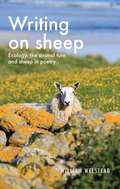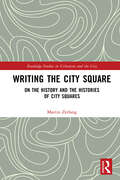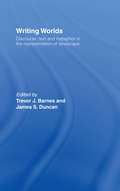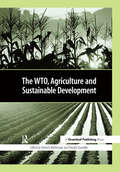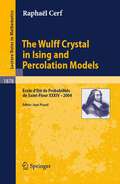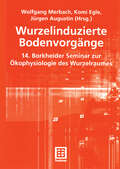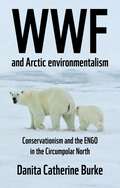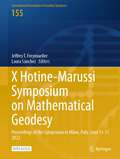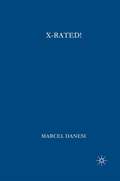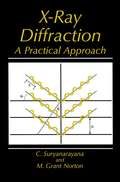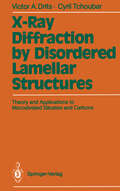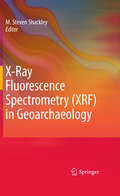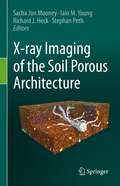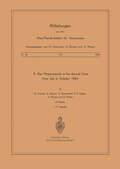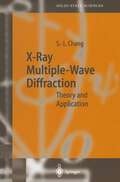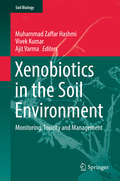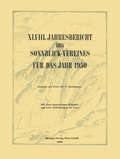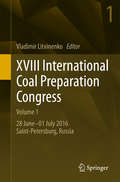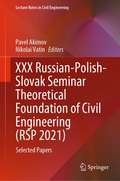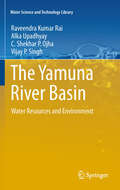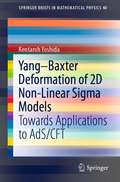- Table View
- List View
Writing on sheep: Ecology, the animal turn and sheep in poetry
by William WelsteadSheep are marginalised in literary criticism and in discussion of pastoral literature. This book brings an animal studies approach to poetry about sheep that allows for the agency of these sentient beings, that have been associated for humans over ten thousand years. This approach highlights the distinction between wild and domesticated species and the moral dilemma between the goals of animal welfare and those of saving species from extinction. Discussion of mostly contemporary poetry follows a new reading of works from the pastoral and georgic canon. Allowing for the sentience and sociality of this species makes it easier to imagine a natureculture within which to make kin across the species boundary. Reading poetry about sheep has the power to make new meanings as we try to adapt to an increasingly complex and problematic environment.
Writing the City Square: On the History and the Histories of City Squares (Routledge Studies in Urbanism and the City)
by Martin ZerlangThe history of cities is also the history of city squares. The agora, the forum, the piazza, the plaza: All presuppose the idea of a center. It’s a material and mental phenomenon. Literature is an important part of this history, and the interplay between the square as physical space and the square as literature is the topic of this book. This is an encyclopedic book combining an overview of the history of city squares with a plethora of analytical examples of its reflection in literature: Literature uses the city square as a frame; city squares serve as frames for drama; novels and other kinds of literature comment on city squares; city squares are sources of inspiration for all sorts of literary activities. Socrates in the agora, Cicero in the Forum, Calderón in the Plaza Mayor, Corneille in the Place Royale, Richardson in Grosvenor Square, James in Washington Square, Woolf in Bloomsbury Square, Döblin and Gröschner in Alexanderplatz, Rodoreda in Diamond Square in Barcelona, DeLillo in Times Square, Al Aswany in Tahrir Square, the Maidanistas in the Maidan of Kyiv: These are just some of the examples presented and analyzed in this book. The book is of direct interest for researchers, students, and professionals such as architects and urban planners, but it is written in a way that makes it accessible for all readers with an interest in urban culture, architecture, history, literature, and cultural studies.
Writing the City Square: On the History and the Histories of City Squares (Routledge Studies in Urbanism and the City)
by Martin ZerlangThe history of cities is also the history of city squares. The agora, the forum, the piazza, the plaza: All presuppose the idea of a center. It’s a material and mental phenomenon. Literature is an important part of this history, and the interplay between the square as physical space and the square as literature is the topic of this book. This is an encyclopedic book combining an overview of the history of city squares with a plethora of analytical examples of its reflection in literature: Literature uses the city square as a frame; city squares serve as frames for drama; novels and other kinds of literature comment on city squares; city squares are sources of inspiration for all sorts of literary activities. Socrates in the agora, Cicero in the Forum, Calderón in the Plaza Mayor, Corneille in the Place Royale, Richardson in Grosvenor Square, James in Washington Square, Woolf in Bloomsbury Square, Döblin and Gröschner in Alexanderplatz, Rodoreda in Diamond Square in Barcelona, DeLillo in Times Square, Al Aswany in Tahrir Square, the Maidanistas in the Maidan of Kyiv: These are just some of the examples presented and analyzed in this book. The book is of direct interest for researchers, students, and professionals such as architects and urban planners, but it is written in a way that makes it accessible for all readers with an interest in urban culture, architecture, history, literature, and cultural studies.
Writing Worlds: Discourse, Text and Metaphor in the Representation of Landscape
by Trevor J. Barnes James S. DuncanWriting Worlds represents the first systematic attempt to apply poststructuralist ideas to landscape representation. Landscape - city, countryside and wilderness - is explored through the discourse of economics, geopolitics and urban planning, travellers descriptions, propaganda maps, cartography and geometry, poetry and painting. The book aims to deconstruct geographical representation in order to explore the dynamics of power in the way we see the world.
Writing Worlds: Discourse, Text and Metaphor in the Representation of Landscape
by Trevor J. Barnes James S. DuncanWriting Worlds represents the first systematic attempt to apply poststructuralist ideas to landscape representation. Landscape - city, countryside and wilderness - is explored through the discourse of economics, geopolitics and urban planning, travellers descriptions, propaganda maps, cartography and geometry, poetry and painting. The book aims to deconstruct geographical representation in order to explore the dynamics of power in the way we see the world.
The WTO, Agriculture and Sustainable Development
by Heinrich Wohlmeyer Theodor QuendlerDespite the Doha declaration of November 2001, the failure to start a new round of global trade negotiations at Seattle in December 1999 and the hostility of protesters to the trade liberalization process and growing global economic and social disparities was a wake-up call for the World Trade Organisation (WTO). The ambitious goal of this ground-breaking book is to identify the strengths and weaknesses of liberalized world trade, in particular in the agricultural sector, and to investigate to what extent the current WTO agreements provide the necessary fail-safe devices to react to trade-related negative impacts on sustainability, environmental protection and food security. The background and interrelationship between the WTO, the tenets of sustainable development and the unique features of the agriculture and forestry sectors are explored, and conclusions regarding the deficits of the world trade system and its conflicts with basic societal goals – such as sustainability – are drawn. Agriculture and forestry have a particular affinity with what the authors call "strong sustainability" and are to be among the major agenda items in forthcoming WTO negotiations. The book proposes that sustainable agricultural production techniques such as integrated and organic farming provide a series of related services to community and environment which could be severely prejudiced by wholesale trade liberalization and the imposition of the large-scale production methods of the mega-trade giants of the USA and Europe. And yet the concept of sustainability is referred to only tangentially in the existing WTO agenda. The WTO, Agriculture and Sustainable Development argues that, without a formal recognition of this failing, the premise that free trade is inherently advantageous for all countries is a falsehood. Further, unfettered liberalization is unsustainable and a social and environmental multilateral framework must be agreed to reinterpret or adapt a host of WTO regulations that are at odds with sustainable development. The core problem is that, under the current system, import duties can only be differentiated by direct goods and services and not by their means of production – sustainable or otherwise. Therefore, a range of environmental policy measures in the agricultural sector, such as the consideration of product life-cycles, the internalization of external costs and a coupling of trade liberalization with ecological obligations are proposed by the authors. In addition, they argue that unsustainable economic short-termism must be curbed and the use of the stick of trade sanctions and the carrot of financial benefits for good environmental performance be permitted to promote sustainable agricultural practices. This book will contribute greatly in addressing the lack of basic theoretical arguments at the intersection between trade and sustainable development – a failing that has already been bemoaned by trade policy-makers. It is highly recommended reading for all those involved or interested in the WTO negotiations, whether from multilateral organizations, governments, industry or civil society.
The WTO, Agriculture and Sustainable Development
by Heinrich Wohlmeyer Theodor QuendlerDespite the Doha declaration of November 2001, the failure to start a new round of global trade negotiations at Seattle in December 1999 and the hostility of protesters to the trade liberalization process and growing global economic and social disparities was a wake-up call for the World Trade Organisation (WTO). The ambitious goal of this ground-breaking book is to identify the strengths and weaknesses of liberalized world trade, in particular in the agricultural sector, and to investigate to what extent the current WTO agreements provide the necessary fail-safe devices to react to trade-related negative impacts on sustainability, environmental protection and food security. The background and interrelationship between the WTO, the tenets of sustainable development and the unique features of the agriculture and forestry sectors are explored, and conclusions regarding the deficits of the world trade system and its conflicts with basic societal goals – such as sustainability – are drawn. Agriculture and forestry have a particular affinity with what the authors call "strong sustainability" and are to be among the major agenda items in forthcoming WTO negotiations. The book proposes that sustainable agricultural production techniques such as integrated and organic farming provide a series of related services to community and environment which could be severely prejudiced by wholesale trade liberalization and the imposition of the large-scale production methods of the mega-trade giants of the USA and Europe. And yet the concept of sustainability is referred to only tangentially in the existing WTO agenda. The WTO, Agriculture and Sustainable Development argues that, without a formal recognition of this failing, the premise that free trade is inherently advantageous for all countries is a falsehood. Further, unfettered liberalization is unsustainable and a social and environmental multilateral framework must be agreed to reinterpret or adapt a host of WTO regulations that are at odds with sustainable development. The core problem is that, under the current system, import duties can only be differentiated by direct goods and services and not by their means of production – sustainable or otherwise. Therefore, a range of environmental policy measures in the agricultural sector, such as the consideration of product life-cycles, the internalization of external costs and a coupling of trade liberalization with ecological obligations are proposed by the authors. In addition, they argue that unsustainable economic short-termism must be curbed and the use of the stick of trade sanctions and the carrot of financial benefits for good environmental performance be permitted to promote sustainable agricultural practices. This book will contribute greatly in addressing the lack of basic theoretical arguments at the intersection between trade and sustainable development – a failing that has already been bemoaned by trade policy-makers. It is highly recommended reading for all those involved or interested in the WTO negotiations, whether from multilateral organizations, governments, industry or civil society.
The Wulff Crystal in Ising and Percolation Models: Ecole d'Eté de Probabilités de Saint-Flour XXXIV - 2004 (Lecture Notes in Mathematics #1878)
by Raphaël CerfThis volume is a synopsis of recent works aiming at a mathematically rigorous justification of the phase coexistence phenomenon, starting from a microscopic model. It is intended to be self-contained. Those proofs that can be found only in research papers have been included, whereas results for which the proofs can be found in classical textbooks are only quoted.
Wurzelinduzierte Bodenvorgänge: 14. Borkheider Seminar zur Ökophysiologie des Wurzelraumes
by Wolfgang Merbach Komi Egle Jürgen AugustinVon einer nachhaltigen Landnutzung wird neben der Erzeugung hochwertiger Produkte auch die Bewahrung der Funktionsfähigkeit von Ökosystemen erwartet. Vor allem die Entwicklung der Pflanzen und des durchwurzelten Bodens kennzeichnen naturnahe als auch agrarische Ökosysteme. Um deren Belastbarkeit und Stabilität einschätzen zu können, sind Kenntnisse über die komplexen Prozesse im Wurzelraum von großem Interesse. Dieses Buch soll einen Beitrag zur Erweiterung unseres Wissens über die Strukturen, Funktionen und Prozesse im Wurzelraum leisten.
WWF and Arctic environmentalism: Conservationism and the ENGO in the Circumpolar North
by Danita Catherine BurkeBased on interviews with WWF representatives and other experts, this book explores WWF’s approach to engagement in the Circumpolar North. It argues that the foundation of WWF’s success in circumpolar engagement is based on four inter-related pillars: legacy, networks, scientific research and communication style. The book argues that WWF has made remarkable strides to distinguish itself in Arctic and northern engagement through its Global Arctic Programme and national organisations and associated offices in the Arctic states. However, WWF’s work and successes are illustrative of the need for environmental and animal rights organisations to adopt a long-term strategy that show commitment to helping in the Arctic and North which factor in the needs and desires of northerners if they want their work to resonate and be welcomed by key northern audiences.
WWF and Arctic environmentalism: Conservationism and the ENGO in the Circumpolar North
by Danita Catherine BurkeBased on interviews with WWF representatives and other experts, this book explores WWF’s approach to engagement in the Circumpolar North. It argues that the foundation of WWF’s success in circumpolar engagement is based on four inter-related pillars: legacy, networks, scientific research and communication style. The book argues that WWF has made remarkable strides to distinguish itself in Arctic and northern engagement through its Global Arctic Programme and national organisations and associated offices in the Arctic states. However, WWF’s work and successes are illustrative of the need for environmental and animal rights organisations to adopt a long-term strategy that show commitment to helping in the Arctic and North which factor in the needs and desires of northerners if they want their work to resonate and be welcomed by key northern audiences.
X Hotine-Marussi Symposium on Mathematical Geodesy: Proceedings of the Symposium in Milan, Italy, June 13-17, 2022 (International Association of Geodesy Symposia #155)
by Jeffrey T. Freymueller Laura SánchezThis open access volume contains the proceedings of the X Hotine-Marussi Symposium on Mathematical Geodesy which was held from 13 to 17 June 2022 at the Politecnico di Milano, Milan, Italy. Since 2006 the series of the Hotine-Marussi Symposia has been under the responsibility of the Inter-Commission Committee on Theory (ICCT) within the International Association of Geodesy (IAG). The ICCT organized the last five Hotine-Marussi Symposia held in Wuhan (2006), Rome (2009, 2013 and 2018), and Milan (2022). The overall goal of the ICCT and Hotine-Marussi Symposia has always been to advance geodetic theory which is indeed documented by the 22 research articles published in these proceedings. The jubilee X Hotine-Marussi Symposium was organized in 10 topical sessions covering all parts of geodetic theory including reference frames, gravity field modelling, adjustment theory, height systems, time series analysis, or advanced numerical methods. In total, 60 participants attended the Symposium who delivered 62 oral and 18 poster presentations. During a special session, five invited speakers discussed two basic concepts of physical geodesy – geoid and quasigeoid.
X-Rated!: The Power of Mythic Symbolism in Popular Culture
by Marcel DanesiMany attack pop culture as a crude 'sexual' and 'celebrity-based' culture that is purportedly bringing about the end of moral values. Renowned semiotician Marcel Danesi adds his signature insight to the debate by delving deep into pop culture through a consideration of symbols. Danesi's treatment of letters, such as the X in 'X-Rated,' the 'i' in 'iPod,' and other such symbols, reveals an ancient mythic structure that blends the sacred and profane dimensions of human psychic life. Danesi takes the reader on a remarkable exploration of the radical turns in American society, a society in which the search for pleasure and sexual expression often reign supreme. X-Rated! is a fascinating trip through what gives pop culture its secret appeal.
X-Ray Diffraction: A Practical Approach
by C. Suryanarayana M. Grant NortonIn this, the only book available to combine both theoretical and practical aspects of x-ray diffraction, the authors emphasize a "hands on" approach through experiments and examples based on actual laboratory data. Part I presents the basics of x-ray diffraction and explains its use in obtaining structural and chemical information. In Part II, eight experimental modules enable the students to gain an appreciation for what information can be obtained by x-ray diffraction and how to interpret it. Examples from all classes of materials -- metals, ceramics, semiconductors, and polymers -- are included. Diffraction patterns and Bragg angles are provided for students without diffractometers. 192 illustrations.
X-Ray Diffraction by Disordered Lamellar Structures: Theory and Applications to Microdivided Silicates and Carbons
by Victor A. Drits Cyril TchoubarNew methods for the determination of the nature, proportion, and distribution of structural defects in microcrystallized lamellar systems are of utmost importance not only to experimentalists but also to theoreticians. Mathematical formalism - indispensable for such analyses - is well-illustrated by various examples, allowing this method to be easily adopted and even to be applied to other solids with lamellar or pseudo-lamellar structures.
X-Ray Fluorescence Spectrometry (XRF) in Geoarchaeology
by M. Steven ShackleySince the 1960s, x-ray fluorescence spectrometry (XRF), both wavelength and energy-dispersive have served as the workhorse for non-destructive and destructive analyses of archaeological materials. Recently eclipsed by other instrumentation such as LA-ICP-MS, XRF remains the mainstay of non-destructive chemical analyses in archaeology, particularly for volcanic rocks, and most particularly for obsidian. In a world where heritage and repatriation issues drive archaeological method and theory, XRF remains an important tool for understanding the human past, and will remain so for decades to come.Currently, there is no comprehensive book in XRF applications in archaeology at a time when the applications of portable XRF and desktop XRF instrumentation are exploding particularly in anthropology and archaeology departments worldwide. The contributors to this volume are the experts in the field, and most are at the forefront of the newest applications of XRF to archaeological problems. It covers all relevant aspects of the field for those using the newest XRF technologies to deal with very current issues in archaeology.
X-ray Imaging of the Soil Porous Architecture
by Sacha Jon Mooney Iain M. Young Richard J. Heck Stephan PethThe advent of X-ray Computed Tomography (CT) as a tool for the soil sciences almost 40 years ago has revolutionised the field. Soil is the fragile, thin layer of material that exists above earth’s geological substrates upon which so much of life on earth depends. However a major limitation to our understanding of how soils behave and function is due to its complex, opaque structure that hinders our ability to assess its porous architecture without disturbance. X-ray imagery has facilitated the ability to truly observe soil as it exists in three dimensions and across contrasting spatial and temporal scales in the field in an undisturbed fashion. This book gives a comprehensive overview of the “state of the art” in a variety of application areas where this type of imaging is used, including soil water physics and hydrology, agronomic management of soils, and soil-plant-microbe interactions. It provides the necessary details for entry level readers in the crucial areas of sample preparation, scanner optimisation and image processing and analysis. Drawing on experts across the globe, from both academia and industry, the book covers the necessary “dos and don’ts”, but also offers insights into the future of both technology and science. The wider application of the book is provided by dedicated chapters on how the data from such imagery can be incorporated into models and how the technology can be interfaced with other relevant technical applications. The book ends with a future outlook from the four editors, each of whom has over 20 years of experience in the application of X-ray CT to soil science.
X-Ray Measurements in the Auroral Zone from July to October 1964 (Mitteilungen aus dem Max-Planck-Institut für Aeronomie #25)
by G. Kremser E. Keppler A. Bewersdorff K. H. Saeger G. Pfotzer W. Riedler J. P. LegrandX-Ray Multiple-Wave Diffraction: Theory and Application (Springer Series in Solid-State Sciences #143)
by Shih-Lin ChangX-ray multiple-wave diffraction, sometimes called multiple diffraction or N-beam diffraction, results from the scattering of X-rays from periodic two or higher-dimensional structures, like 2-d and 3-d crystals and even quasi crystals. The interaction of the X-rays with the periodic arrangement of atoms usually provides structural information about the scatterer. Unlike the usual Bragg reflection, the so-called two-wave diffraction, the multiply diffracted intensities are sensitive to the phases of the structure factors in volved. This gives X-ray multiple-wave diffraction the chance to solve the X-ray phase problem. On the other hand, the condition for generating an X ray multiple-wave diffraction is much more strict than in two-wave cases. This makes X-ray multiple-wave diffraction a useful technique for precise measure ments of crystal lattice constants and the wavelength of radiation sources. Recent progress in the application of this particular diffraction technique to surfaces, thin films, and less ordered systems has demonstrated the diver sity and practicability of the technique for structural research in condensed matter physics, materials sciences, crystallography, and X-ray optics. The first book on this subject, Multiple Diffraction of X-Rays in Crystals, was published in 1984, and intended to give a contemporary review on the fundamental and application aspects of this diffraction.
Xenobiotics in the Soil Environment: Monitoring, Toxicity and Management (Soil Biology #49)
by Muhammad Zaffar Hashmi Vivek Kumar Ajit VarmaThis book describes the vast variety of xenobiotics, such as pesticides, antibiotics, antibiotic resistance genes, agrochemicals and other pollutants, their interactions with the soil environment, and the currently available strategies and techniques for soil decontamination and bioremediation. Topics covered include: transport mechanisms of pollutants along the Himalayas; use of earthworms in biomonitoring; metagenomic strategies for assessing contaminated sites; xenobiotics in the food chain; phyto-chemical remediation; biodegradation by fungi; and the use of enzymes and potential microbes in biotransformation. Accordingly, the book offers a valuable guide for scientists in the fields of environmental ecology, soil and food sciences, agriculture, and applied microbiology.
XVIII International Coal Preparation Congress: 28 June—01 July 2016 Saint-Petersburg, Russia
by Vladimir LitvinenkoThis book gathers technical and scientific articles by leading experts from 15 countries and originally presented at the world’s most prestigious forum on coal preparation: the XVIII International Coal Preparation Congress. Topics addressed include: the mineral resources basis of the coal industry; problems and prospects of development in the coal industry; crushing, grinding, screening and classification processes used at sorting plants; coal processing and briquette factories; review of plant designs and operations used around the world; new developments in dense-medium separators, water-based separation processes, froth flotation and dewatering; technologies and equipment for the dry separation of coal; coal deep processing technologies and equipment; energy generation as an area of coal deep processing; and simulation and optimization software for separation processes.In general, the future of coal around the world is defined by its competitiveness. As the cheapestform of fuel (comparatively speaking), coal undoubtedly continues to be in high demand around the world.
XXX Russian-Polish-Slovak Seminar Theoretical Foundation of Civil Engineering: Selected Papers (Lecture Notes in Civil Engineering #189)
by Pavel Akimov Nikolai VatinThis book gathers the latest advances, innovations, and applications in the field of civil, environmental and construction engineering, as presented by researchers and engineers at the XXX Annual Russian-Polish-Slovak Seminar Theoretical Foundation of Civil Engineering (RSP), held in September 2021. Co-organized by six universities from Russia, Poland and Slovakia, the event covered diverse topics such as structural mechanics; building structures; geodesy and geotechnics; transport and environmental issues in civil engineering. The contributions, which were selected by means of a rigorous international peer-review process, highlight numerous exciting ideas that will spur novel research directions and foster multidisciplinary collaborations.
The Yamuna River Basin: Water Resources and Environment (Water Science and Technology Library #66)
by Raveendra Kumar Rai Alka Upadhyay C. Shekhar Ojha Vijay P. SinghThis book is designed to provide concepts, methodologies, and approaches for river basin studies with respect to water resources and environment. The book is not limited to the Yamuna River basin, but will help in the study of various other river basins for integrated water resources management. The book covers the essential components of integrated water resources management, including analysis of climatic variables, climate change detection, analysis of natural resources, geology, geomorphology, socio-economics, water budgeting, flood estimation, river pollution, etc. Furthermore, the book addresses recent issues pertaining to water quality, water quality indices, environmental flows, water resources management through cropping pattern change, etc. along with methodologies and application to the Yamuna River system. However, the main objective of this book is to address important issues of water resources management of river basins. Audience: The manuscript has been designed so that it can be used as a reference for river basin studies. The book will be useful to engineers, agricultural scientists, environmentalists, planners, managers, and administrators who are concerned with water resources.
Yang–Baxter Deformation of 2D Non-Linear Sigma Models: Towards Applications to AdS/CFT (SpringerBriefs in Mathematical Physics #40)
by Kentaroh YoshidaIn mathematical physics, one of the fascinating issues is the study of integrable systems. In particular, non-perturbative techniques that have been developed have triggered significant insight for real physics. There are basically two notions of integrability: classical integrability and quantum integrability. In this book, the focus is on the former, classical integrability. When the system has a finite number of degrees of freedom, it has been well captured by the Arnold–Liouville theorem. However, when the number of degrees of freedom is infinite, as in classical field theories, the integrable structure is enriched profoundly. In fact, the study of classically integrable field theories has a long history and various kinds of techniques, including the classical inverse scattering method, which have been developed so far. In previously published books, these techniques have been collected and well described and are easy to find in traditional, standard textbooks. One of the intriguing subjects in classically integrable systems is the investigation of deformations preserving integrability. Usually, it is not considered systematic to perform such a deformation, and one must study systems case by case and show the integrability of the deformed systems by constructing the associated Lax pair or action-angle variables. Recently, a new, systematic method to perform integrable deformations of 2D non-linear sigma models was developed. It was invented by C. Klimcik in 2002, and the integrability of the deformed sigma models was shown in 2008. The original work was done for 2D principal chiral models, but it has been generalized in various directions nowadays. In this book, the recent progress on this Yang–Baxter deformation is described in a pedagogical manner, including some simple examples. Applications of Yang–Baxter deformation to string theory are also described briefly.
